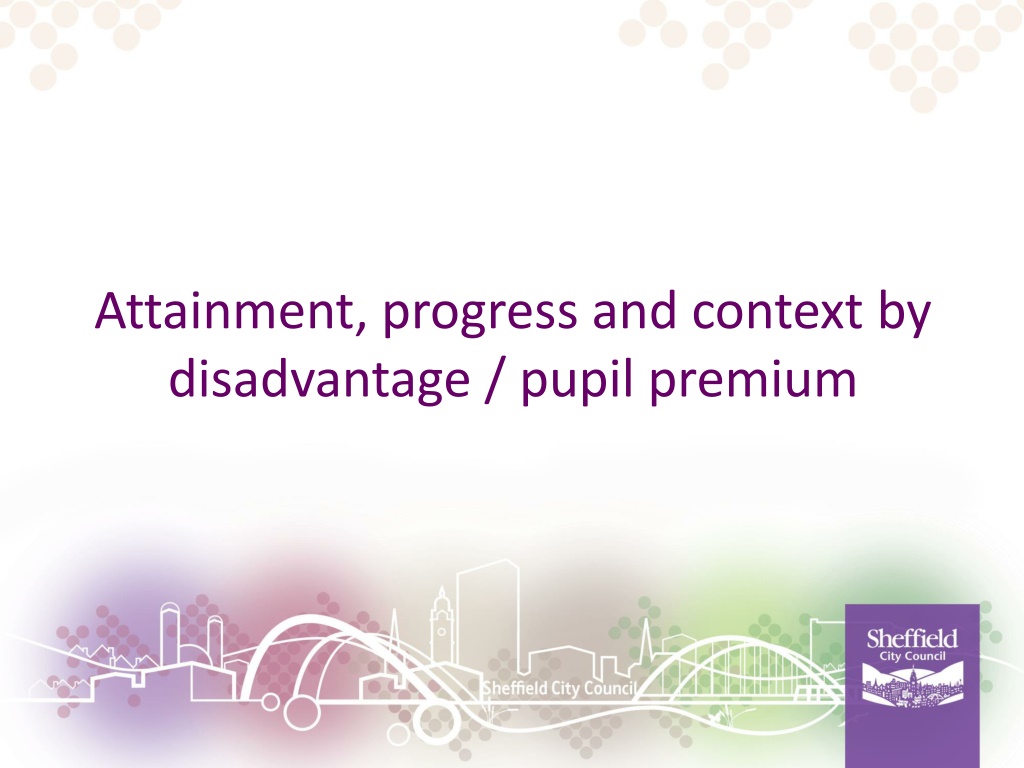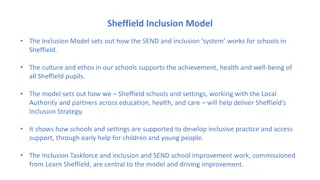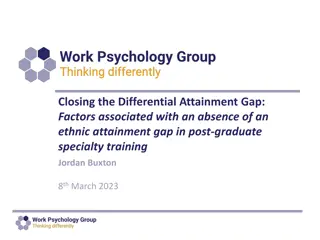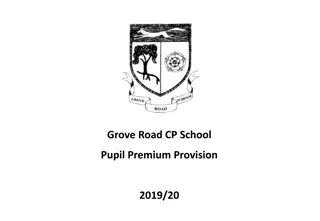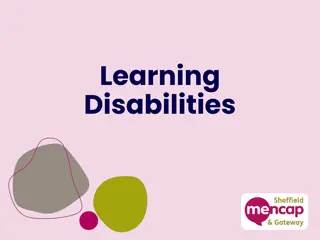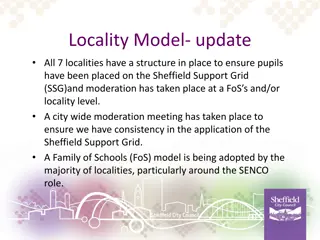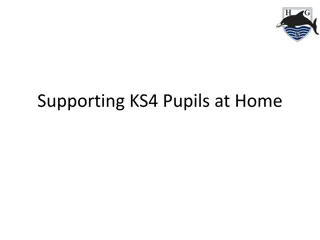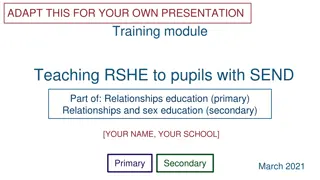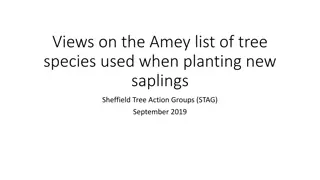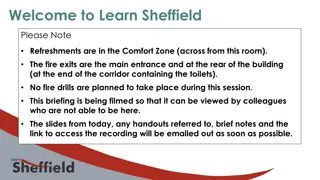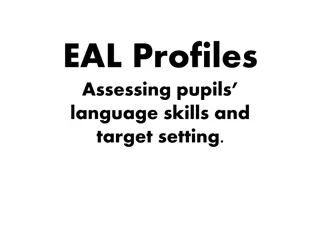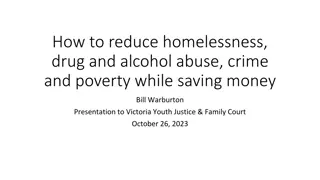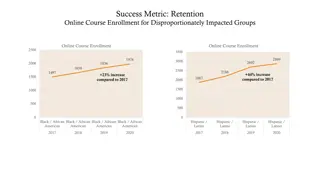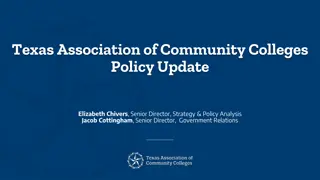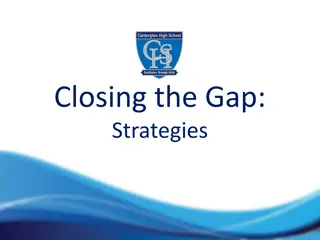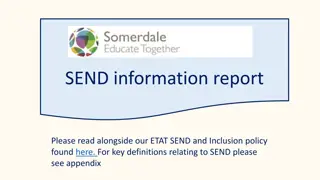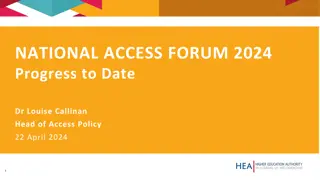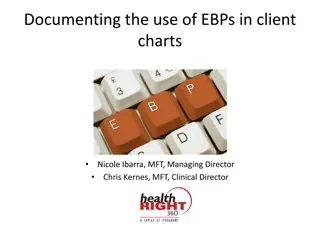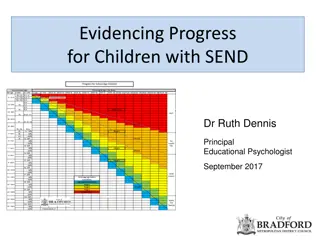Improving Attainment and Progress of Disadvantaged Pupils in Sheffield
Attainment and progress of disadvantaged pupils in Sheffield show an improving trend across key stages, although the gaps between disadvantaged and non-disadvantaged students are not closing fast enough. Data suggests that disadvantaged pupils with low prior attainment are making better progress in Key Stage 2 compared to non-disadvantaged pupils with similar starting points. However, in general, disadvantaged pupils make less progress than their non-disadvantaged counterparts. The percentage of pupils eligible for pupil premium in Sheffield is higher than the national average, with a significant increase in secondary phase eligibility since 2014. Despite improvements in Foundation Stage and phonics, there remains a gap between pupil premium and non-pupil premium pupils. Key Stage 1 data also highlights disparities in attainment levels between disadvantaged and non-disadvantaged pupils nationally.
Download Presentation

Please find below an Image/Link to download the presentation.
The content on the website is provided AS IS for your information and personal use only. It may not be sold, licensed, or shared on other websites without obtaining consent from the author. Download presentation by click this link. If you encounter any issues during the download, it is possible that the publisher has removed the file from their server.
E N D
Presentation Transcript
Attainment, progress and context by disadvantage / pupil premium
Summary pupil premium / disadvantaged The attainment of disadvantaged pupils is improving across all key stages but the gaps between disadvantaged and non-disadvantaged pupils are not closing fast enough. When the cohort is split into prior attainment groups pupils in Sheffield generally achieve the same or better than pupils with similar prior attainment nationally. Exceptions to this are reading at KS2 (attainment and progress), KS2 maths attainment for pupils with high prior attainment and KS2 maths progress for pupils with low prior attainment. Disadvantaged pupils with low prior attainment make better progress in KS2 than non-disadvantaged pupils with similar starting points; however, in general disadvantaged pupils make less progress than non-disadvantaged pupils. 2
Summary pupil premium / disadvantaged 30% of primary age pupils and 34% of secondary age pupils in Sheffield are eligible for the pupil premium. Both these figures are around 5% points higher than the national average. The % of pupils eligible for the pupil premium in the secondary phase has increased significantly since 2014 whilst there has been a recent drop in the primary phase, mirroring the national trend. 3
Foundation Stage / Phonics There is an improving trend for both pupil premium and non pupil premium pupils at Foundation Stage and Phonics but the gap between the two groups is not closing. The performance of non pupil premium pupils is above the national average at Foundation Stage and similar to the national average for phonics. 4
Key Stage 1 reading Charts show overall attainment (top left) and difference between Sheffield and national in terms of number of pupils. Note that disadvantaged pupils in Sheffield are compared to non- disadvantaged pupils nationally. Pupils are split into groups based on their Foundation Stage attainment. 5 Note: data from RAISE, the disadvantaged pupil groups includes children in care and children adopted from care
Key Stage 1 writing For all subjects (reading, writing and maths) a higher % of pupils achieved the expected standard in Sheffield compared to all pupils nationally when pupils are split into Foundation Stage attainment groups. 6
Key Stage 1 maths There are gaps within all subjects for disadvantaged pupils when these pupils are compared to non- disadvantaged pupils nationally. The gaps are largest for pupils with the lowest attainment levels at Foundation Stage. 7
Key Stage 2 reading At KS2 there is a gap of 1% for low and middle attaining groups in reading. As at KS1, disadvantaged pupils are compared to non-disadvantaged pupils nationally. The gap is largest for the middle attaining group. 8
Key Stage 2 writing Pupils in Sheffield generally achieved better results in writing than pupils with similar prior attainment nationally. There is a gap between the performance of disadvantaged pupils in Sheffield and non- disadvantaged pupils nationally for middle attaining pupils. 9
Key Stage 2 maths The performance of middle attaining pupils in maths was above the national average. Middle and high attaining disadvantaged pupils did less well than non-disadvantaged pupils nationally at expected and greater depth. 10
Key Stage 2 combined measure Overall pupils in Sheffield have done better than pupils with the same level of prior attainment nationally. Disadvantaged pupils with middle and high prior attainment have performed less well than non- disadvantaged pupils nationally. 11
Key Stage 2 progress Low attaining disadvantaged pupils make better progress compared to all pupils in every subject. Progress in reading is below the national average across all pupil groups, except high attaining pupils. Progress in writing is above the national average for all pupil groups. Progress in maths is below average for low attaining pupils and disadvantaged pupils. 12
Key Stage 4 36% of disadvantaged pupils in Sheffield achieved an A*-C grade in both English and maths, this compares to 69% of non- disadvantaged pupils. Disadvantaged pupils also score lower on Progress 8 with an average score of 0.15 for non disadvantaged pupils and -0.35 for disadvantaged pupils. The largest gap in progress 8 scores between disadvantaged and non disadvantaged is in relation to the EBacc element of Progress 8. 13
Key Stage 4 by prior attainment Splitting the cohort by prior attainment group still shows that disadvantaged pupils make less progress across all attainment groups. Disadvantaged pupils with high KS2 attainment have the lowest progress 8 scores, achieving on average a third of a grade lower than expected across all subjects. The % of pupils achieving a C or above in English and maths is higher in Sheffield than nationally across all attainment groups. However, disadvantaged pupils perform less well across all prior attainment groups. 14
Attainment, progress and context by first language and ethnicity
Summary BME & EAL The % of pupils with EAL and BME pupils have been increasing in Sheffield more rapidly than the national average since 2012. Rates of EAL and BME in special schools in Sheffield are significantly higher than the national average and have increased more rapidly in the last 2 years. Rates of EAL and BME are currently higher in the primary phase and should therefore increase in secondary schools in later years. Around 63% of BME pupils are also recorded as having EAL, this figure varies little by age group or over time. A significant number of EAL pupils have not been in an English school since age 5. Attainment gaps between EAL / non EAL and BME White British have persisted over time however EAL and BME pupils typically make significantly better progress than their White British peers. The gap between the attainment of EAL and non EAL pupils in reading appears to have increased under the new national curriculum at KS1 and KS2. 16
EAL & BME trends Source: January school census Source: January school census The % of pupils with EAL has been increasing in Sheffield more rapidly than the national average since 2012. Between 2015 and 2016 there has been a slight decrease in the rate of increase for BME and EAL. Rates of EAL and BME in special schools in Sheffield are significantly higher than the national average and have increased more rapidly in the last 2 years. 17
EAL & BME by year group % of BME / EAL pupils is lower in secondary year groups Around 63% of BME pupils are also recorded as having EAL. This figure has changed little over time and does not vary between year groups. 18
Language trends For primary age groups the number of Slovak speakers appears to be stabilising but there has been an increase in Romani speakers in 2016. The number of Slovak speakers in secondary schools is increasing as more of these children reach secondary age. There appears to be a small increase in Arabic speakers with both primary and secondary phases. 19
Ethnicity trends In terms of ethnicity, most of the growth in numbers is due to small increases across a number of different ethnic groups. Whilst Roma pupils accounted for significant increases in past years the increase in pupil numbers between 2015 and 2016 has slowed down. 20
New arrivals It is possible to estimate how many pupils joined Sheffield schools from overseas in each year. For Y6 pupils in 2016, approximately 22% of EAL learners had not been in the English school system since the start of Year 1. The % of pupils starting school in year 5 or year 6 has reduced since 2014. This suggests that the number of new arrivals in the primary phase is possibly stabilising or even reducing. In the secondary phase the % of pupils starting school within the last 2 years is higher in the younger age groups but has reduced overall since 2014. 21
New arrivals / EAL by school The chart shows the number of EAL pupils in the 2016 KS2 cohort by school. EAL pupils are concentrated within a relatively small number of schools. Only 36 schools had 10 or more EAL pupils in Y6 in 2016. Within schools with high numbers of EAL pupils there is significant variation in terms of the type of EAL pupil. There are schools with high number of EAL pupils but very few recently arrived EAL pupils (for example: High Hazels, Sharrow, Nether Edge) Other schools have a lower number of EAL learners but a relative high % of recently arrived EAL learners (for example: Pye Bank, Whiteways, Lowfield, Limpsfield, Pipworth, Oasis Fir Vale) Pye Bank Whiteways / Lowfield Limpsfield Pipworth Oasis Fir Vale 22
EAL / BME attainment trends Foundation Stage & Phonics Increase in attainment for Foundation Stage and Phonics over time for all groups but gaps for BME / EAL are not closing 23
EAL / BME attainment trends KS1 New assessment framework so no trend data at KS1. Gap between EAL / non EAL largest in reading and smallest in writing 24
EAL / BME attainment trends KS2 attainment New assessment framework so no trend data at KS2. The new expected standard is higher than the previous level 4 and the % of pupils achieving the expected standard has therefore decreased for all pupil groups. 25
EAL / BME attainment trends KS2 progress New progress measures at KS2 are value-added. National average is 0. Progress in reading is negative for all groups pupils in Sheffield made less progress than national average but little difference between EAL and non EAL. BME pupils made less progress in reading than White British. BME and EAL pupils made significantly more progress in writing and maths than White British / non EAL. 26
KS2 by ethnicity Considering the ratio of the attainment of BME pupils compared to the attainment of all pupils, the gap has widened between BME pupils and the Sheffield average in the first year of assessment under the new national curriculum. 27
Key Stage 4 headline measures Accountability measures at KS4 have also changed. New headline measures include C+ in English and maths and progress 8. Progress 8 measures progress across a set of 8 subjects including English, maths and Ebacc subjects. Whilst EAL and BME pupils are less likely to achieve the attainment thresholds (C+ in English and maths), the progress 8 score for these pupils is higher. 28
Key Stage 4 progress 8 components For each progress 8 component, EAL and BME pupils perform better than their comparator group achieving a positive progress score for all components with the exception of BME pupils in English. 29
